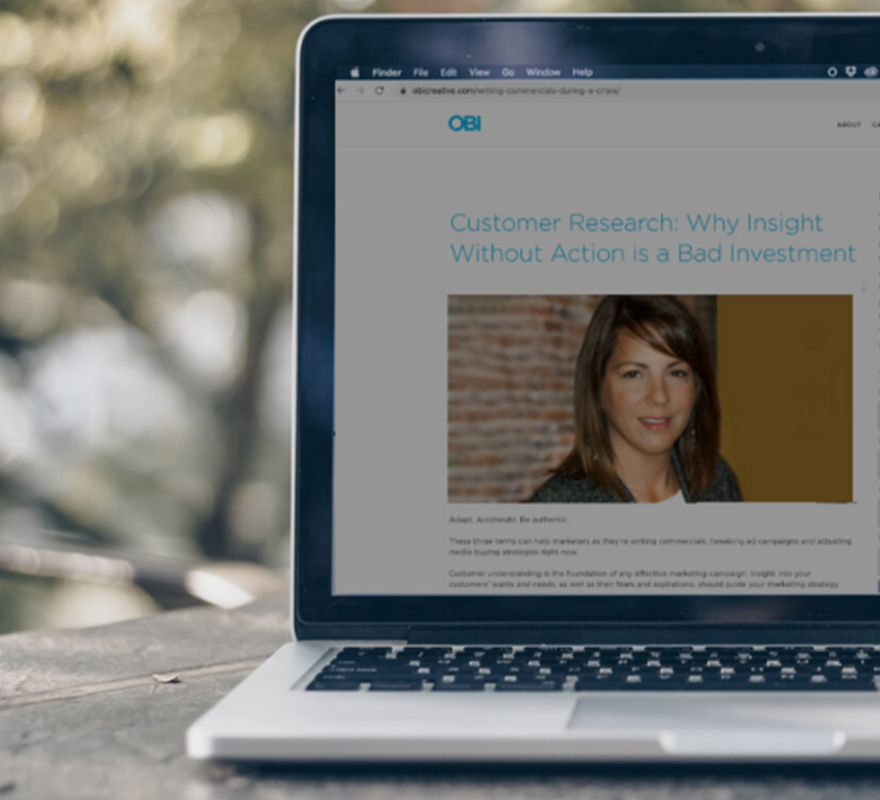Customer Research: Why Insight Without Action Is a Bad Investment
Conducting customer research is an investment, so it makes no sense to gather insight into a customer’s experience with your brand and not act on that insight. Sometimes the lack of action is caused by unintelligible data. Other times, companies are simply unwilling or unready to accept what customer research reveals.
OBI Creative’s research team, led by VP of Strategic Customer Growth Diva Ham, helps brands avoid this costly error by forging a different approach to research — one that is based on action and results.
“We challenge clients’ perceptions,” Ham says. “We challenge clients’ perceptions of their customers, the buyer journey and the business challenges they face. Raw data on its own is rarely actionable. Solid research design leads to authentic insights that culminate in recommended action plans. That process forms the foundation for profitable customer experience research.”
Decades of experience conducting market research for Fortune 500 companies has led Ham to conclude that following three principles will lead to profitable market research.
3 Keys to Conducting Customer Research
It’s easy to get lost in the numbers when it comes to market research. Ham says by putting research goals front and center, tying ROI to actionable insights and being open to results regardless of what they reveal about your operations will lead to profitable research activities.
1. Let Research Goals Define Research Design
Any worthwhile research project begins with a set of clear goals for that research.
“It’s easy to get caught up in combing through numbers or making assumptions or decisions based on data without taking a step back and asking if you’re tracking data that will help you reach your business objectives,” says Ham. “Your research firm should be spending time upfront with you to gain thorough understanding of your business goals, challenges and opportunities so that knowledge can inform the survey design process.”
Many companies invest in annual surveys to gauge whether customer perception about their brand has changed over the course of the year. Survey design is incredibly important in gaining reliable insights on such surveys. Consider two examples.
A national member-based organization experiencing membership losses wants to know how many of its members consider it to be trustworthy, so it conducts a simple survey asking members to confirm word associations with its brand. Results reveal that 80% of customers surveyed find the organization trustworthy. Yet the organization continues to experience net member loss. Why?
To answer this question, the survey design must go beyond word association to determine what trustworthiness means to members. Is it a driver of membership? Or are other criteria driving the perceived value of membership? Without improving the survey design, the organization will lack the insight it needs to reverse membership trends.
Consider a second example. Again, a national organization conducts an annual survey of consumers to discern if its brand is being perceived in a more or less positive light than it was a year ago. While the survey design remains unchanged from year to year, the respondents change. Each year, a new set of respondents are asked whether their perception of the brand improved or declined over the past year.
Yet no follow-up questions are asked to determine the cause of any potential shift in perception. And different respondents are solicited each year. Without a consistent baseline and adequate follow-up questions to better understand survey responses, the research is of little value.
In both cases, having clearly defined research goals, tied to business objectives, that informed research design upfront would have led to actionable insights, which are critical for achieving desired ROI on any research effort.
2. Tie ROI to Action
Research is an investment. Not being able to prove its value is unacceptable.
“The purpose of market research should always be to uncover insights that can lead to action that can help your business grow,” says Ham. “You have to get the data, but that’s worthless if you don’t act on it.”
If you are responsible for reading out research reports to executive leadership within your organization, it’s critical, Ham says, to make sure you, and they, understand what the data means to your organization and, more specifically, what action to take on it.
Therefore, one of the goals of your research activities should be to generate a specific number of actionable insights that your company can move on as soon as data results are available. Assign specific ROI values to those actionable insights so that when you read out research results you can follow up a predetermined amount of time later with leadership to show progress on action items connected to that research.
Actionable insights should ladder up to business objectives, ensuring alignment with organizational goals and overall profitability.
3. Be Open to the Results
A final principle to put into practice with your research efforts is to be open to the results.
If the research design is sound and actionable insights are tied to its goals, which support organizational initiatives, you can rest assured that the results will help you grow. They may contradict your assumptions about the customer journey or experience with your brand, but that is no reason to ignore them.
“You may be tempted to reject data when you don’t like it or when you believe customer perception doesn’t align with operational reality,” says Ham. “But what is branding if not perception? Every perception should be considered and disappointing results should not be invalidated. If you don’t know about something, you can’t do anything about it. Even if it’s not true, ignoring it won’t make it go away.”
Instead, combat customer perceptions with renewed efforts, led by research results, to address weak points along the customer journey. Make sure you understand how your research is generating results and change when necessary.
A Final Word: 4 Questions To Ask Your Customer Research Firm
Advertising and market research have a causal relationship with one another; well-designed research can form the foundation for effective advertising campaigns that deliver the results companies seek.
However, they share a commonality as well. When successful, both advertising and market research are viewed as magical and believed to be achieved through some secret combination of experience and intuition.
In reality, marketing and research succeed when they are informed by strategy and connected to results.
Before engaging in any new research project, ask yourself if you are tracking those things that align with your business objections. Will your research design allow you to achieve your business objectives?
Then, ask your research firm about its survey design. Questions like the following are helpful:
- What process will be used to design the survey instrument?
- Can we have access to the full data report?
- Are you delivering insights into what that data means for our organization or just the results?
- What is your population sample? Whom did you survey?
While it might seem too forward at first to ask questions like these, it’s critical to ensuring you get actionable insights that will help you achieve business objectives.
Are you ready for better research? OBI Creative is here to help. Reach out today for customer research that delivers actionable insights.




